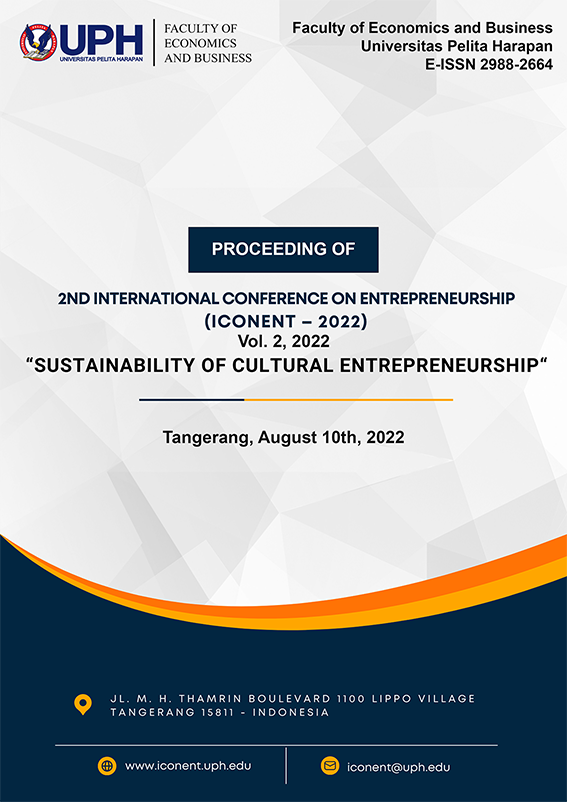CUSTOMERS USING DIGITAL WALLET PLATFORMS AS A METHOD OF PAYMENT IN WEST JAKARTA
Keywords:
Dana Application, Perceived Credibility, Perceived Usefulness, Subjective normAbstract
One form of electronic payment is the e-wallet. In Indonesia, many e-wallet products are available from both the public and private sectors. DANA is an e-wallet program that has previously received authorization from the Bank of Indonesia as a supplier of an e-wallet platform and as a digital financial institution. In 2018, DANA was introduced, and in its first four months, it attracted a million members. This study aimed to identify the variables that influence West Jakarta's adoption of DANA as an alternative payment method. Data were collected via a Google form online survey. Social networking sites like Instagram, Line, and internet discussion boards shared the link. DANA subscribers who reside in West Jakarta made up the respondents. In roughly two months, the data were gathered. This study included 187 respondents using SPSS as a tool for data filtering and multiple regression analysis. The findings suggested that perceived usefulness, perceived credibility, and subjective norm are the main factors influencing whether or not DANA will be accepted. All of these criteria significantly influenced users' decisions to utilize DANA.
References
[1] BPS Indonesia, “Keadaan Ketenagakerjaan Indonesia Agustus 2019,” Badan Pus. Stat., vol. XXiI, no. 91, pp. 1-20, 2021.
[2] “Countries with the most Instagram users 2022,” Statista Research Department, 2022. https://www.statista.com/statistics/578364/countries-with-most-instagram-users/.
[3] Statista, “FinTech Digital Market Outlook,” Statista, 2022. https://www.statista.com/outlook/dmo/fintech/indonesia.
[4] A. Sikri, S. Dalal, N. . Singh, and D. Le, “Mapping of e”Wallets With Features,” Cyber Secur. Parallel Distrib. Comput., no. March, pp. 245-261, 2019, doi: 10.1002/9781119488330.ch16.
[5] F. D. Davis, “Davis 1989.pdf,” Information Technology. 1989, doi: 10.2307/249008.
[6] F. D. Davis, “Perceived usefulness, perceived ease of use, and user acceptance of information technology,” MIS Q. Manag. Inf. Syst., vol. 13, no. 3, pp. 319-339, 1989, doi: 10.2307/249008.
[7] Y. S. Wang, Y. M. Wang, H. H. Lin, and T. I. Tang, “Determinants of user acceptance of Internet banking: An empirical study,” 2003, doi: 10.1108/09564230310500192.
[8] Y. J. Lim, A. Osman, S. N. Salahuddin, A. R. Romle, and S. Abdullah, “Factors Influencing Online Shopping Behavior: The Mediating Role of Purchase Intention,” Procedia Econ. Financ., vol. 35, no. October 2015, pp. 401-410, 2016, doi: 10.1016/s2212-5671(16)00050-2.
[9] T. K. Das and B. S. Teng, “The risk-based view of trust: A conceptual framework,” J. Bus. Psychol., vol. 19, no. 1, pp. 85-116, 2004, doi: 10.1023/B:JOBU.0000040274.23551.1b.
[10] M. PilÃk, “Selected factors influencing customers’ behaviour in e-commerce on B2C markets in the Czech Republic,” 7th Eur. Conf. Inf. Manag. Eval. ECIME 2013, pp. 121-128, 2013.
[11] P. Verma and S. Jain, “Skills Augmenting Online Shopping Behavior: A Study of Need for Cognition Positive Segment,” Bus. Perspect. Res., vol. 3, no. 2, pp. 126-145, 2015, doi: 10.1177/2278533715578556.
[12] W. Y. Wu and C. C. Ke, “An online shopping behavior model integrating personality traits, perceived risk, and technology acceptance,” Soc. Behav. Pers., vol. 43, no. 1, pp. 85-98, 2015, doi: 10.2224/sbp.2015.43.1.85.
[13] S. Shin and W. J. Lee, “The effects of technology readiness and technology acceptance on NFC mobile payment services in Korea,” J. Appl. Bus. Res., vol. 30, no. 6, pp. 1615-1626, 2014.
[14] J. Trivedi, “Factors Determining the Acceptance of E-Wallet,” J. Appl. Mark. Manag., 2016.
[15] Y. P. Mun, H. Khalid, and D. Nadarajah, “Millennials’ Perception on Mobile Payment Services in Malaysia,” 2017, doi: 10.1016/j.procs.2017.12.170.
[16] A. W. Yan, K. Md-Nor, E. Abu-Shanab, and J. Sutanonpaiboon, “Factors that affect mobile telephone users to use mobile payment solution,” Int. J. Econ. Manag., 2009.
[17] Sugiyono., Metode Penelitian Bisnis (pendekatan Kuantitatif, Kualitatif, dan R&D). Bandung: Alfabeta, 2013.
[18] Sugiyono, Metode Penelitian Kuantitatif, Kualitatif, dan R&D. Bandung: Alfabeta, 2018.
[19] I. Ghozali, Aplikasi Analisi Multivariate dengan Program IBM SPSS 25. Semarang: Badan Penerbit Universitas Diponegoro, 2018.
[20] J. F. Hair, W. C. Black, B. J. Babin, and R. E. Anderson, Multivariate data analysis, Eight Edit. Boston: Cengage, 2019.
[21] K. G. Jöreskog, U. H. Olsson, and F. Y. Wallentin, Springer Series in Statistics Multivariate Analysis with LISREL. 2016.
[22] J. F. Hair, M. Sarstedt, L. Hopkins, and V. G. Kuppelwieser, “Partial least squares structural equation modeling (PLS-SEM): An emerging tool in business research,” Eur. Bus. Rev., vol. 26, no. 2, pp. 106-121, 2014, doi: 10.1108/EBR-10-2013-0128.
[23] D. L. Amoroso and R. Magnier-Watanabe, “Building a research model for mobile wallet consumer adoption: The case of mobile Suica in Japan,” J. Theor. Appl. Electron. Commer. Res., 2012, doi: 10.4067/S0718-18762012000100008.
[24] Y. Pooi, H. Khalid, and D. Nadarajah, “ScienceDirect ScienceDirect Millennials ’ Perception on Mobile Payment Services in Malaysia,” Procedia Comput. Sci., vol. 124, pp. 397-404, 2018, doi: 10.1016/j.procs.2017.12.170.

 Fakultas Ekonomi dan Bisnis | Universitas Pelita Harapan | Kampus Universitas Pelita Harapan | Gedung F Lt. 12 | Lippo Karawaci, Tangerang - 15811 | Telp 021-5460901 | Fax 54210992
Fakultas Ekonomi dan Bisnis | Universitas Pelita Harapan | Kampus Universitas Pelita Harapan | Gedung F Lt. 12 | Lippo Karawaci, Tangerang - 15811 | Telp 021-5460901 | Fax 54210992